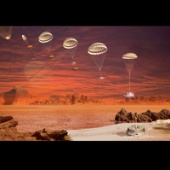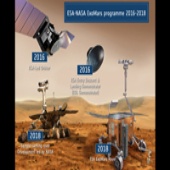ESA Science & Technology - News Archive
News archive
News archive
[20.01.2010]
A study based on data collected by the four ESA Cluster satellites and the CNSA/ESA Double Star TC-1 spacecraft, provides new insight into the location and duration of ruptures in the Earth's magnetic shield.
A study based on data collected by the four ESA Cluster satellites and the CNSA/ESA Double Star TC-1 spacecraft, provides new insight into the location and duration of ruptures in the Earth's magnetic shield.
Published: 20 January 2010
Observations of faint and distant galaxy groups made with the European Space Agency's XMM-Newton observatory have been used to probe the evolution of dark matter.
Published: 20 January 2010
Published: 18 January 2010
The HIFI instrument onboard Herschel has been successfully switched on, after being inactive due to an unexpected anomaly in the electronic system. This achievement brings Herschel back to its full observing capacity.
Published: 18 January 2010
Exactly five years ago today the European Space Agency's (ESA) Huygens Probe made history when it landed on Titan, the largest moon in the Saturnian system.
Published: 14 January 2010
The draft version of the Fundamental Physics Roadmap (FPR) document is now available. The FPR draft document will be presented to the scientific community and discussed at the FPR Workshop that takes place at ESTEC on 21-22 January 2010, after which the document will be finalized.
Published: 13 January 2010
The Gaia project recently passed another major milestone with the completion of three of the 10 payload mirrors. Final acceptance for the M5 and two M4 mirrors was granted by Delivery Review Boards conducted towards the end of 2009.
Published: 11 January 2010
On 14 January 2005 the European Space Agency's Huygens probe separated from the Cassini spacecraft and landed on Saturn's moon Titan. A dedicated conference will mark the 5th anniversary of this remarkable event.
Published: 8 January 2010
Published: 8 January 2010
The NASA/ESA Hubble Space Telescope has broken the distance limit for galaxies and uncovered a primordial population of compact and ultra-blue galaxies that have never been seen before.
Published: 5 January 2010
Using the Hubble Space Telescope, astronomers have uncovered two distinct kinds of rejuvenated stars (blue stragglers) in the globular cluster M30. A new study shows that two different processes are responsible for this cosmic face lift.
Published: 23 December 2009
Initial results from the Herschel science demonstration phase have been presented by and to the scientific community at a workshop organised by the Herschel Science Centre and held 17-18 December 2009 in Spain.
Published: 21 December 2009
The technical review reports for the six medium-class (M-class) candidate missions in the Cosmic Vision 2015-2025 plan are now available. The reports present the outcome of ESA's internal review of the six M-class candidate missions.
Published: 18 December 2009
The ESA Council has just given the go-ahead to proceed with the implementation of the ExoMars Programme. This decision paves the way for two Mars exploration missions in cooperation with NASA in 2016 and 2018.
Published: 17 December 2009
Thirty never-before-released images of embryonic planetary systems in the Orion Nebula are the highlight of the longest single Hubble Space Telescope project ever dedicated to the topic of star and planet formation
Published: 14 December 2009
On 10 December 1999 Ariane 504 blasted off from Kourou in French Guiana carrying onboard ESA's flagship X-ray observatory, XMM-Newton. In the intervening decade this astronomical workhorse has played a significant role in revolutionizing X-astronomy.
Published: 10 December 2009
The new Wide Field Camera 3 aboard the NASA/ESA Hubble Space Telescope has taken the deepest image yet of the Universe in near-infrared light
Published: 8 December 2009
Published: 3 December 2009
A series of formal presentations on the 6 medium-class candidate missions in the Cosmic Vision 2015-2025 plan was made to a large gathering of Europe's scientific community on 1 December.
Published: 2 December 2009
A recent NASA/ESA Hubble Space Telescope image of part of NGC 7023, or the Iris Nebula, highlights a perfect dust laboratory in the sky.
Published: 1 December 2009
—
20 Items per Page


















